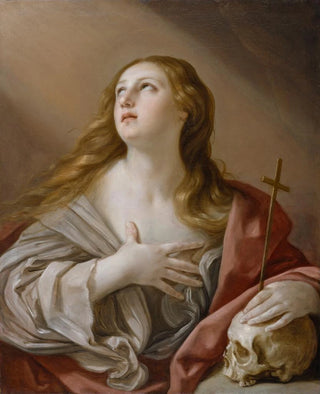Art print | The Penitent Magdalene - Guido Reni


View from behind

Frame (optional)
In the vibrant world of baroque art, "The Penitent Magdalene" by Guido Reni stands out as an iconic work, captivating the eye and the mind with its emotional depth and refined aesthetics. This depiction of Mary Magdalene, a symbolic figure of repentance and redemption, proves to be much more than a simple religious image. It embodies a quest for spirituality and an exploration of themes of suffering and grace, propelling the viewer into introspective reflection. The way Reni captures this biblical figure, transforming her into an icon of human beauty and pain, makes it an essential work of the 17th century.
Style and uniqueness of the artwork
Guido Reni's style is distinguished by his masterful use of light and shadow, a technique that gives his characters an almost divine dimension. In "The Penitent Magdalene," the light gently caresses the saint's face, highlighting her delicate features and her expression of melancholy. The artist plays with contrasts, creating an atmosphere that is both intimate and contemplative. The drapery of her garment, subtly rendered, adds to the scene's sensuality while emphasizing the fragility of her spiritual state. This work also stands out for its harmonious composition that guides the viewer's gaze toward Mary Magdalene's face, thus accentuating her silent eloquence. The absence of superfluous details allows emotion to fully express itself, making this painting of rare evocative power.
The artist and his influence
Guido Reni, born in Bologna in 1575, is one of the masters of Italian baroque, recognized for his ability to combine classical rigor with touching expressiveness. Trained at the Accademia degli Incamminati, he established himself with a unique style that blends ideal beauty with emotional sensitivity. His influence extends far beyond his era, inspiring many artists through the centuries. Reni was able to capture the essence of humanity in his works, creating characters that seem to live and breathe on the canvas.

Matte finish

View from behind

Frame (optional)
In the vibrant world of baroque art, "The Penitent Magdalene" by Guido Reni stands out as an iconic work, captivating the eye and the mind with its emotional depth and refined aesthetics. This depiction of Mary Magdalene, a symbolic figure of repentance and redemption, proves to be much more than a simple religious image. It embodies a quest for spirituality and an exploration of themes of suffering and grace, propelling the viewer into introspective reflection. The way Reni captures this biblical figure, transforming her into an icon of human beauty and pain, makes it an essential work of the 17th century.
Style and uniqueness of the artwork
Guido Reni's style is distinguished by his masterful use of light and shadow, a technique that gives his characters an almost divine dimension. In "The Penitent Magdalene," the light gently caresses the saint's face, highlighting her delicate features and her expression of melancholy. The artist plays with contrasts, creating an atmosphere that is both intimate and contemplative. The drapery of her garment, subtly rendered, adds to the scene's sensuality while emphasizing the fragility of her spiritual state. This work also stands out for its harmonious composition that guides the viewer's gaze toward Mary Magdalene's face, thus accentuating her silent eloquence. The absence of superfluous details allows emotion to fully express itself, making this painting of rare evocative power.
The artist and his influence
Guido Reni, born in Bologna in 1575, is one of the masters of Italian baroque, recognized for his ability to combine classical rigor with touching expressiveness. Trained at the Accademia degli Incamminati, he established himself with a unique style that blends ideal beauty with emotional sensitivity. His influence extends far beyond his era, inspiring many artists through the centuries. Reni was able to capture the essence of humanity in his works, creating characters that seem to live and breathe on the canvas.






